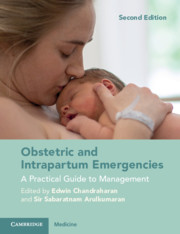Book contents
- Obstetric and Intrapartum Emergencies
- Obstetric and Intrapartum Emergencies
- Copyright page
- Contents
- Contributors
- Preface
- Preface to the First Edition
- Acknowledgements
- Section 1 General Principles
- Section 2 Algorithms for Management of the Top Five ‘Direct Killers’
- Section 3 Intrapartum Emergencies
- Section 4 Postpartum Emergencies
- Section 5 Medical and Surgical Emergencies During Pregnancy
- Section 6 Anaesthetic Emergencies During Pregnancy
- Chapter 32 General Anaesthesia and Failed Intubation
- Chapter 33 Fluid Overload and Underload
- Chapter 34 Transfusion and Anaphylactic and Adverse Drug Reactions in Pregnancy
- Chapter 35 Major Trauma Including Road Traffic Accidents
- Section 7 Neonatal Emergencies and the Management of Immediate Neonatal Problems
- Section 8 Management of Anticipated and Non-anticipated Emergencies in Pregnancy
- Section 9 Setting-Up Skills and Drills Training in Maternity Services and Reducing Avoidable Harm
- Index
- References
Chapter 35 - Major Trauma Including Road Traffic Accidents
from Section 6 - Anaesthetic Emergencies During Pregnancy
Published online by Cambridge University Press: 06 May 2021
- Obstetric and Intrapartum Emergencies
- Obstetric and Intrapartum Emergencies
- Copyright page
- Contents
- Contributors
- Preface
- Preface to the First Edition
- Acknowledgements
- Section 1 General Principles
- Section 2 Algorithms for Management of the Top Five ‘Direct Killers’
- Section 3 Intrapartum Emergencies
- Section 4 Postpartum Emergencies
- Section 5 Medical and Surgical Emergencies During Pregnancy
- Section 6 Anaesthetic Emergencies During Pregnancy
- Chapter 32 General Anaesthesia and Failed Intubation
- Chapter 33 Fluid Overload and Underload
- Chapter 34 Transfusion and Anaphylactic and Adverse Drug Reactions in Pregnancy
- Chapter 35 Major Trauma Including Road Traffic Accidents
- Section 7 Neonatal Emergencies and the Management of Immediate Neonatal Problems
- Section 8 Management of Anticipated and Non-anticipated Emergencies in Pregnancy
- Section 9 Setting-Up Skills and Drills Training in Maternity Services and Reducing Avoidable Harm
- Index
- References
Summary
Blunt trauma is the most common type of trauma in pregnancy, being caused mainly by road traffic accidents. Different mechanisms of injury give rise to a variety of injury patterns. Blunt forces commonly cause compression injuries, particularly laceration or fracture of solid organs. Sudden deceleration and consequent shearing forces cause avulsion of peritoneal attachments or arteries. Rapid increase in abdominal pressure, for example from a seat belt, can result in hollow viscus rupture or rib or pelvic fractures and cause laceration injuries.
- Type
- Chapter
- Information
- Obstetric and Intrapartum EmergenciesA Practical Guide to Management, pp. 252 - 260Publisher: Cambridge University PressPrint publication year: 2021



